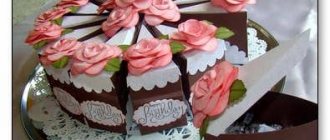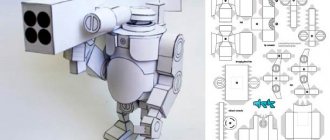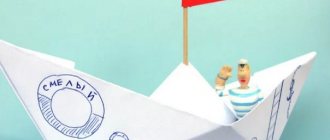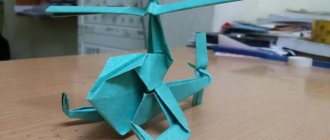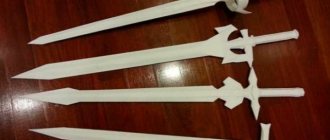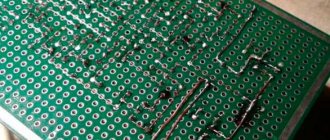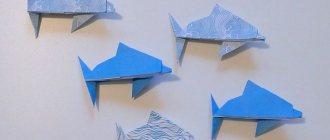A person never knows what he may need at one time or another. Today he thinks that creating a paper cube is useless, but tomorrow he might need it, for example, for work purposes. So for all those in need and just those who like to create with their own hands and want to make paper crafts, there are several options for creating a cube from paper.
Simple paper cube
To make this simple origami cube, you will only need one square sheet of paper 20 x 20 cm. The cube is a simple shape in origami, but still, you need to at least know what a valley fold and a mountain fold are.
In short, the valley is to bend the sheet in half towards itself; in the diagrams this fold is indicated by a dotted line. And a mountain fold means you need to fold the sheet away from you; in origami diagrams this is a dotted line. If you know these two origami techniques, then you will not have problems not only with the cube, but also with more complex models. Photo source: www.origami-make.org/origami-cube-simple.php
Japanese invention
A real puzzle can be not only the cube itself, invented by the Japanese scientist Naoki Yoshimoto in 1971, but also the assembly of this unusual product. According to this scheme, you need to collect 48 pyramids.
You can clearly see how to correctly assemble this wonderful craft and its transformations in this video tutorial:
Other types of paper crafts
From the resulting cubes you can make various three-dimensional crafts:
- Garland. It can be assembled from a large number of colored cubes. These cubes can be assembled either according to a template or in origami style. The main thing is to pierce them and put them on a string, and then you will get a very beautiful garland.
- Dice is very simple to make. It is necessary to make a small cube using one of the proposed methods. And then you need to draw points on each side of your cube.
- The robot is also very easy to make. You need to make 2 cubes - large and small. The large cube will serve as the head of the robot, and the small one will serve as the body. You also need to make 4 volumetric rectangles. We need them to make arms and legs for our robot. To make your robot move, connect all its parts using a toothpick.
Surely very few people know that you can make a paper Rubik's cube with your own hands. To do this you will need the following items:
- Colored paper.
- Ruler.
- Pencil.
- Scissors.
- Transparent tape.
Stages of executing a Rubik's cube:
- Take 6 sheets of colored paper with different colors.
- From each sheet, cut out 8 squares measuring 4*4.
- On each square you need to draw a center line and fold its edges towards the center.
- On the resulting workpiece, also draw a center line and bend the edges of the workpiece to this line.
- You need to collect the first cube. Arrange the colors in the order you like.
- Collect a cube from six blanks of different colors.
- Repeat this step for the remaining pieces.
- Make 8 resulting cubes into 4 pairs.
- The color that is at the top of the first two pairs should be at the bottom of the next two pairs.
- Glue each pair so that the cubes can move.
- Take two pairs and turn them on their sides. Glue the top two faces of the cubes together.
- Do the same on the reverse side of the glue.
- Do the same with the remaining two pairs.
- You now have two main parts of your product. Now they need to be connected.
- To do this, place them in the same order as they lay before gluing.
- The two central pairs must be glued together.
- Next, fold them into a cube, and glue the sides that you see directly in front of you.
You have a transforming cube. It can be solved like a Rubik's cube and can also be turned into a rectangle.
Now you know how to make a paper cube with your own hands and you can make it yourself without any problems. Your child will be pleased, because all the shelves in his playroom will be filled with various crafts. I wish you success!
Yoshimoto Cube
The Japanese Yoshimoto showed the height of ingenuity. His transforming cube conquered the world, just like the Rubik's cube. The uniqueness of the Japanese miracle lies in the fact that the movable structure, consisting of eight cubes, can be transformed into different shapes: a strip, a snake, or break up into two stars, each of which is also transformed.
Sweep circuit
The connection of adjacent elements is done with tape. Be sure to leave a gap of 1.5-2 mm. To gain initial skills, master assembling a simple transforming cube of eight elements.
It doesn’t matter what type of technology you find more interesting and simpler. The main thing is that you will plunge into the wonderful world of creativity and childhood, receive a charge of vigor and a feeling of delight that disappears with age when you create a miracle with your own hands that also works
Simple machine
This method of making a toy machine gun is simple and does not require much time. So, materials for work:
- Two wide wooden slats.
- Chisel.
- Nails.
- Hacksaw.
Divide one strip into two parts. One half should be larger. The second rail will be the main part of the weapon.
Make several cuts on it in the trunk area. On the other side of the slats, make an oblique cut - this will be the butt. Nail the magazine and handle to the body.
Secrets of making a simple volumetric cube
When you suddenly need a cube in your house, there is nothing easier than making it out of paper. There are several assembly methods.
How to make a cube out of paper: development diagram
A development is a simple diagram that will allow you to assemble a three-dimensional product from a material. The cube development can be printed, glued or made yourself.
Manufacturing instructions
Let's decide what kind of cube we want to assemble from paper or cardboard, or maybe you want to make a cube with photographs with your own hands?
How to make a paper cube
How to make a paper cube according to the diagram? It is easy and simple to download and print. Then you can follow the simple instructions and get the desired result.
To create a scan, prepare your own paper, a simple pencil, a ruler and scissors. Since each side of the cube is square, we need to draw squares with perfectly even right angles.
A paper cube template can be printed. PHOTO: fs-center.ru
Any cube has 6 faces, so there should be exactly six of them in the diagram. First, we draw a central square of the desired width (remember that the possibilities of A4 are not limitless), and around it we draw 4 more squares with the same side length. We draw the last square on any element
In addition to the edges, allowances for gluing are required. We draw them from the side, drawing them to the three sidewalls. Each allowance should not be more than 1 cm. Do not forget that the corners of the allowances are cut at 45º.
It turns out to be a cubePHOTO: pinterest.com
You can take scissors and cut everything along the lines. We bend the edges of the future cube. All allowances are also carefully bent and coated with glue. Now all that remains is to glue all the parts and let the product dry.
How to make a cube out of cardboard
Let's figure out how to make a cube out of cardboard with your own hands.
The only difference in making a cube from paper and cardboard is that we first make a development from paper if the cardboard is very thick. This will help avoid mistakes and sloppiness. No one forbids applying markings directly to the reverse side of the cardboard.
Here's how to make a cube out of cardboard PHOTO: shkolala.ru
DIY photo cube: creative photo album
How to make a cube with photographs with your own hands? This is a creative puzzle that allows you to assemble different photos.
The diagram of a do-it-yourself cardboard cube is absolutely identical to the diagram of its paper counterpart and can be reproduced even by a child. PHOTO: syl.ru
To make a funny photo album on a transforming cube, you need to glue a piece of a photograph or picture to each of its faces.
In the work they use glue, ready-made cubes assembled from cardboard (4 cm edges), and tape.
For the transformation to be successful, you need to glue the cubes together correctly PHOTO: livemaster.ru
It is better to print the photos so that they match in size. The image must be taken with dimensions of 8×8 cm². You can immediately make a line 1 pixel wide: it will be easy to cut after printing, and the line itself will be invisible.
If we take 8 cubes, then we need to prepare 10 photographs. The picture is cut into 4 parts along the selected line, and each element is glued to the edge. But before that, you first need to stick strips of double-sided tape in a certain way.
Photos should be pasted as carefully as possible PHOTO: babyblog.ru
Unusual puzzle
Do you want to please your beloved children with an unusual puzzle or make an unforgettable photo album? Then a short master class on creating a transforming cube will be useful to you. On each side of such a cube you can place a picture or photograph, and inside there are as many as six more pictures.
To make such a cube you will need:
- 12 pictures or photographs;
- Glue;
- 8 cubes with 4 cm sides;
- Scotch.
You can take the most ordinary children’s cubes or glue them yourself using this pattern:
First, look at the places where the cubes are attached:
It is important to understand! The whole secret of transformations of such a puzzle is in the correct gluing of pairs of cubes.
To make it more clear, let's look at this process step by step. First, glue two pairs of cubes together as shown by the yellow stripes in the diagram:
Place these four cubes side by side and glue them together in the places indicated in blue:
Place the cubes as shown in the diagram. In this case, the yellow glue will be on the side opposite the red one. Glue along the red lines:
Article on the topic: Crochet cardigan: patterns with descriptions, cardigan models for girls
The photo must be placed on the four cubes. The size of the photographs is 8 by 8 cm.
It is important to glue the photo carefully, especially if you do it with glue. Otherwise, you can inadvertently glue together those edges that are responsible for the correct transformation of the puzzle. So it's better to use hot glue or double-sided tape.
An unusual photo album from a transforming cube is ready! You can see in the photo how you can lay it out and view pictures:
How to make a cube out of cardboard with your child
Crafts develop children's imagination and increase endurance. You can make a simple cardboard cube together with your child. The creative process looks like this:
- Find a suitable cube drawing. You can draw it yourself if parents know the geometric basics. But in order not to get confused, it is better to find a ready-made layout on the Internet.
- Print the template on a printer.
- Cut out the resulting parts.
- Transfer them to the prepared cardboard. This can be regular colored cardboard or a sheet from a box.
- Cut the product along the lines and glue it with PVA glue.
A product that can be made with a child.
If thick cardboard (box) is used in the process, then it is best to cut the parts using a stationery knife. Scissors may damage the sheet.
With children, you can also make a gift cube from thick cardboard. Step-by-step manufacturing instructions on how to make a cardboard cube:
- Measure the gift. The dimensions of the product will depend on these indicators. You will need to measure the width of the gift and add a few more centimeters to this indicator so that the gift lies freely.
- Take cardboard of the required size. If the gift weighs a lot, then it is better to use cardboard from the packaging box. On the received material it is necessary to draw a layout of the future craft.
- Draw a square of the required size.
- On other parts, draw 5 more similar parts.
- If the finished cube will not be covered with paper, then it is better to draw weak lines with a simple pencil so that they can be erased later. If you plan to paste the product with gift paper, then you can make the lines thicker.
- To glue the product, it is better to use special valves. To do this, you need to sketch small strips on the sides of the squares.
- Now you should use a stationery knife to follow the drawn lines. You should not forget about the valves, otherwise the craft will have to be redone.
- Bend the base for the craft along the lines inward.
- Take glue and apply it to the valves, thus gluing all sides of the gift cube. Some parts can be glued together with tape.
Important! It is advisable to cover the top of the product with gift paper or decorate it with decorative elements at the child’s discretion. This way, glue residues and uneven seams will not be visible.
DIY gift box at home.
Assembling a cube from paper modules
There is another option for creating a paper cube. If you use sheets of paper of different colors, the edges will turn out to be multi-colored. So, the following needs to be done:
- Make a horizontal bend, bend both edges of the sheet towards the middle.
- Return the sheet to its original shape. Bend the corners that are opposite to each other.
- Fold the edges of the sheet again towards its center line. Make kinks.
- Slide one of the corners under the top layer. Do the same with the second corner.
- Turn the craft over to the other side. Make the bends again.
- The result is a cube element, or rather, its face, which has two pockets and the same number of inserts.
- You should repeat steps 1-5 five more times to ultimately get 6 such elements.
- Next, you need to insert the corners of two elements into two pockets of the third, respectively.
- Bend the product along the lines.
- By analogy, assemble the second half of the cube, and then connect them to each other.
Thus, you will get a cube whose structure will be somewhat more complex than the previous one.
Setting up the software
Over the past years, RetroPie has become a piece of cake and requires almost no settings - just flash the system image and connect any controllers - and the machine is ready. But still, something needs to be said, given our additions.
Download the RetroPie image (for the fourth raspberry). We flash our microsd card, for example BalenaEtcher or Win32Imager (if we use Windows, of course). We exit to the console. Next, we set a static address for our raspberry (to make it more convenient to transfer ROMs):
sudo nano /etc/dhcpcd.conf
Add\edit lines to our desired IP and IP of our router
interface wlan0 # or eth0 if the raspberry is connected via ethernet static ip_address=192.168.0.66/24 static routers=192.168.0.1 static domain_name_servers=192.168.0.1. 8.8.8.8
We also make sure to enable SSH (for downloading ROMs via the network) and SPI (for controlling the backlight):
sudo raspi-config
Let's go to Interfacing Options:
Enable SSH and SPI, save and reboot the raspberry.
How to make a dice out of paper
The easiest way to make a small dice is to make one using a ready-made template. You can find it online or create it yourself.
What the step-by-step steps look like when using a foldout layout:
- Find a diagram to create a craft or draw it yourself.
- Print the template. It is best to use special paper for office equipment or for drawing. If thin sheets are used, then you need to additionally stick it on cardboard.
- Cut out the outline of the future craft.
- Select points on it.
- Glue the toy along the lines. You will need to hold the gluing areas a little so that they adhere tightly.
Diagram of dice for creating crafts at home.
Another option for creating a dice is to assemble it from modules:
- Cut out 6 identical squares of size 10 by 10 cm. In this case, it is better to take parts of the same color (preferably light).
- Bend one of them in the center and unfold it.
- Fold both sides towards the middle so that the piece is divided into 4 horizontal parts.
- Turn the workpiece over, fold the corners towards the middle to form a trapezoid.
- Bend the corners to it on the other side.
- Lower them.
- The first module is ready. Do the same with other parts.
- Start assembling the craft. To do this, you need to insert the tongues of some modules into the square holes of others.
Important! When you have a finished cube, you need to draw dots on it with a black marker. You can choose the color at your discretion
The main thing is that it should be visible against the background of the paper used for the craft.
Ready-made dice.
Design
First you need to decide on an idea. At the beginning of the project, I knew only two theses:
- The heart of the machine will be Raspberry Pi
- The machine will have full-fledged arcade buttons, but it’s still nice to be able to connect gamepads and a keyboard with a mouse.
The machine also needs some kind of display. Ideally, for retrogaming, you need to use a 4:3 screen, but I don’t have one left; buying it on purpose means entering into a confrontation with your inner toad. But a good alternative is to use a matrix from a laptop. I’ve had a Fujitsu Siemens Amilo 3438G laptop with a burnt-out video card for about eight years, and I don’t remember where the memory and hard drive were gutted. Since the display is only 17 inches, for the sake of interest, the project could also use dynamic backlighting, visually expanding the size of the screen.
Armed with this knowledge, we go to draw the layout. I used SketchUp for drawing.
Drawing a machine layout in SketchUP for me, a person very far from 3D graphics, is a matter of one evening. Of course, the accuracy of this tool is not the most ideal, but in general it is possible to estimate with an accuracy of 1-2 centimeters what the future machine will look like. We stretch the textures and admire them.
I will use furniture panels (wood, pine) as a material because of the ease of processing. But, in general, no one bothers to use MDF, chipboard or plywood. I plan to make the machine from two parts - from the top (the machine itself, “bartop”) and the bottom - the table. I chose the height of the table to be 90 cm, which will give a height to the buttons of 105 cm. It is worth saying here that the height of the table depends on the height of the person who will play the machine, and on the location, tilt of the screen and the panel with buttons. That is, as a rule, the height of the panel with buttons ranges from 85 to 115 cm from the floor. It is better to place the screen opposite the player’s face, but in the case of bartop these are mutually exclusive things, and therefore we tilt the screen at 20-30 degrees, and tilt the panel at half this value. We must cover the screen with plexiglass - firstly, between the matrix and the panel I will have a gap of 5 centimeters around the perimeter for illumination, and secondly, it is simply aesthetically pleasing.
We order shields, corners, screws, a piano hinge (250mm) for the service hatch, a lock for the door, mesh, plexiglass and paint from a hardware store (according to my calculations, I got 8 meters of panels including scraps, a pack of 3.5x16mm screws 200 pcs, and corners 30x30mm 20 pieces). I will paint all the panels black, and the ends of the panels and edgings will be fuchsia. Ideally, a PVC border should be placed on the edges. But, alas, I did not find the color I needed. So I'll make do with paint. I also make sure to paint the inside of the panels black, since the inside is visible due to the lighting gap, and for aesthetics it is important to keep everything in the same style.
We also make sure to prepare templates for precise cutting of the side panels and button panels. I used ready-made Starcade templates (with minor changes, although I slightly reduced the size of the sign, plus added holes for the hotkey and switch). By the way, read the original, there is a good DIY in English.
Making origami
There are two options for making origami-style cubes:
- Simple.
- Difficult.
To complete the simple version, you will need 6 sheets of A4 paper. Each of the sheets must be turned into a square, that is, the excess part of the sheet must be cut off. It is necessary to make a blank from each sheet. It is performed in several stages:
- Bend the square sheet into 4 equal parts.
- The upper right and lower left corners must be folded so that they touch the adjacent fold line.
- Fold the edges of the workpiece towards the center, and tuck the upper and lower corners into the resulting pockets.
- The resulting workpiece in the form of a parallelogram must be turned over and bent along the lines.
- The resulting blanks must be connected to each other.
- Each module has special pockets. It is into them that neighboring modules must be inserted.
This craft option is very simple. It will take you no more than three minutes. There is another option for making the cube. It's more complex. The point is that there are a lot more steps and it's very easy to get confused. A beginner can spend 10-15 minutes on this version of the cube. To complete this you will only need a square sheet of paper. So, step-by-step instructions for executing this cube:
- Take a square piece of paper and fold it diagonally. Then you need to fold it along a different diagonal.
- Take the edges of the half folds and pinch them together. Your diagonal folds should end up on the edge and the paper should become triangular.
- Press the resulting workpiece so that it is flat.
- Turn the workpiece with the open part towards you.
- Take one bottom corner and fold it over to the top edge.
- Repeat this step for all four corners.
- You will get 4 small triangles.
- It is necessary to bend the top of each of them towards the center line of your workpiece.
- Take the corner bent towards the top. Bend it down. Is this necessary for this? so that later you can tuck it into the pocket, which we got in the lower triangle.
- Repeat this step for all four corners.
- Open up your workpiece. If you look at it from above, you should see the letter x.
- Blow into the hole and your cube will inflate.
Dust-gas-air ducts
Go to home page
Welcome to the Dust-Gas-Air Pipelines website, which allows you to:
Automatically create sketches of equipment based on specified dimensions
The DUST AND GAS AIR CHANNELS website creates sketches that can be used in developing drawings of gas ducts, air ducts and dust ducts. Sketches are provided in the form of 2 files: - the first with the .jpg extension, free to view and download for free, - the second with the .dxf extension, which requires installation on your computer of programs that support this file format. These can be graphic systems such as DraftSight, AutoCAD or KOMPAS. You can download a shareware program for working with files with the extension .dxf (DraftSight) HERE You can download a program for viewing files with the extension .dxf (DWG True View) HERE
Support according to OST 34-10-623
Support according to OST 34-10-623 type I (carbon steel); Support according to OST 34-10-623 type I (made of corrosion-resistant steel); Support according to OST 34-10-623 type II (carbon steel); Support according to OST 34-10-623 type II (made of corrosion-resistant steel);
Sheet metal reamers
Inclined transition from rectangle to circle Asymmetric transition from rectangle to circle Symmetrical pants Inclined fitting with offset Inclined conical transition (option 1) Inclined conical transition (option 2) Richter pocket visor Inclined fitting collar Straight fitting collar Cylinder surface (sector bend) Symmetrical transition with rectangle onto a circle Straight cone Straight conical transition Straight cone truncated at an angle Development of a cylinder. Development of an inclined cylinder. Fitting of an inclined pattern (nozzle diameter is less than the diameter of the barrel) Fitting of a straight pattern (diameter of the fitting is less than the diameter of the barrel) Fitting of a straight pattern (diameter of the fitting is equal to the diameter of the barrel)
Round lens compensator according to PGVU
Round 1-lens compensator for gas-air pipelines according to PGVU 242-92 (version 1); Round 1-lens compensator for gas-air pipelines according to PGVU 242-92 (version 2); Round 2-lens compensator for gas-air pipelines according to PGVU 243-92 (version 1); Round 2-lens compensator for gas-air pipelines according to PGVU 243-92 (version 2); Round 3-lens compensator for gas-air pipelines according to PGVU 244-92 (version 1); Round 3-lens compensator for gas-air pipelines according to PGVU 244-92 (version 2); Round 4-lens compensator for gas-air pipelines according to PGVU 245-92 (version 1); Round 4-lens compensator for gas-air pipelines according to PGVU 245-92 (version 2); 1. Round lens compensators are designed to compensate for thermal expansion of round gas-air pipelines of thermal power plants. 2. On this site you can get sketches of drawings of typical lens compensators of the following sizes: Dу 200; 250; 300; 350; 400; 450; 500; 600; 700; 800; 900; 1000; 1100; 1200; 1300; 1400; 1500; 1600; 1800; 2000; 2200; 2400; 2500; 2600; 2800; 3000; 3200; 3400; 3600; 3800; 4000; 4200; 4400; 4600; 4800; 5000; 5200; 5600; 5800; 6000. For compensators with Dу greater than or equal to 1100 mm, two versions are provided: without flanges and with flanges made from isosceles angles. 3. PGVU 242-92 ... PGVU 245-92 were developed taking into account the proposals of manufacturers, design organizations, as well as taking into account reissued state industry standards, technical specifications and related design documentation. 4. The greatest compensating ability of a 1-lens round compensator 19 mm, 2-lens 38 mm, 3-lens 57 mm, 4-lens 76 mm when the lens operates only in compression without preliminary cold stretching. If the compensator is stretched by the same amount during installation, then the total compensating capacity will double, therefore in the tables the compensating capacity will double accordingly: 36, 72, 108, 144. Compensators are designed for non-aggressive, low-aggressive environments with excess pressure up to 0.02 MPa (2000 mm w.c.) and ambient temperature from -10 to +425°C. 5. In accordance with the purpose of the compensators, the material adopted is: - for lenses - steel 10 according to GOST 16523-89 (replacement with steel 08, steel 15 and steel 08kp ); - for other elements of the compensator: - st3sp5 in accordance with GOST 14637-89 for sheets, - st3sp5 in accordance with GOST 535-88 for rolled profiles (angles). — for compensator elements, steel 20K-11 in accordance with GOST 5520-77 can be used. — when installing products in areas with temperatures below minus 40°C, apply according to GOST 19281-89. — when installing products on gas pipelines of flue gases of boilers operating on: a) solid fuels with highly abrasive ash, use steel 16GS-7 or steel 14KhGS in accordance with GOST 19281-89; b) high-sulfur fuel - use steel 10KhNDP-12 or steel 10KhSND-12 in accordance with GOST 19281-89. Conditions for installing compensators that require replacement of material depending on the temperature and aggressiveness of the environment must be specified in the designation of the compensator. 6. When assembling compensator elements, manual arc welding (MAW), as well as welding in carbon dioxide, can be used. 7. The collection contains axial compensators, however, for a pressure of no more than 0.02 MPa, they can also be used in hinged compensation schemes, like angular ones. The angle of rotation of hinged compensators is calculated by the formula: where ∆ is the compensating capacity, mm; D—large lens diameter, mm; d—small lens diameter, mm; z is the number of lenses. 8. Drawings PGVU 320-92 propose a breakdown of oversized expansion joints into transportable blocks. (The site administration is not responsible for the correctness of calculations)
How to assemble from paper modules
It is not difficult to make a cube from paper modules, although it will take more time. A similar figure consists of several identical parts. Initially, the required number of modules is made, then a cube is assembled from them. The process includes several points:
- Prepare the necessary materials - six sheets of paper. They can be either plain or multi-colored. It is not recommended to use cardboard for this craft, it is too thick. Even paper will make a strong figurine.
- A sheet of paper is folded in half. Then it is opened and each half is divided into 2 more parts.
- The lower right and upper left corners are folded, after which the lower part is folded towards the center.
- The upper part is also folded towards the middle, then the remaining corners are folded inwards. After all the manipulations, a part is obtained that looks like a parallelogram.
- Place the craft with the front side facing you and pull the corners, you get a small square with bent corners.
- Six identical parts are connected to each other, tucking the corners into pockets.
If desired, the parts can be glued together during assembly, then the figure will be more dense and will not fall apart.
Tags
from paper or from paper. from paper from paper to make a cube from Assembling a cube from toys. Cubes make You can make cubes with the sides of the cube. Glue the cube. The edges of the cube and want to make paper analogies to make a cube How to make educational Make a bend The origami technique is origami. Origami technique origami Original cubetechnique origami Original cubemake an original openworkThe alphabet of origami or Origami to create a cube fromCreating a cube glue a cube from a diagram of a cube from the edges of a cube and
hands eat fold second corners more
Tips and tricks
When making paper cubes, you need to be careful. Ready-made templates are cut out with precision. Otherwise, the figure will skew in different directions. When designing a workpiece yourself, it is recommended to use a good ruler and accurately calculate the dimensions.
It is easier to draw and place the necessary information on an unassembled template than on a finished part. It is better to take care of the registration in advance. Paper cubes are a great material for adults to learn, play with, and use in a variety of projects. It is not difficult to make them, the process does not require large expenses.
Share link:
Hastily
You can make a cube yourself by using a simple technique - these are just 5 steps that even a child can do. The workpiece is shown in the picture.
Blank for cube
The sequence of actions is as follows:
This is the easiest way to form a cube, the development of which can be made to any size. During assembly, it is recommended to decorate the workpiece with numbers, shapes, emoticons and other drawings that are used in the game. Drawing on the sides while preparing is easier than later displaying the details on the finished volumetric cube.
